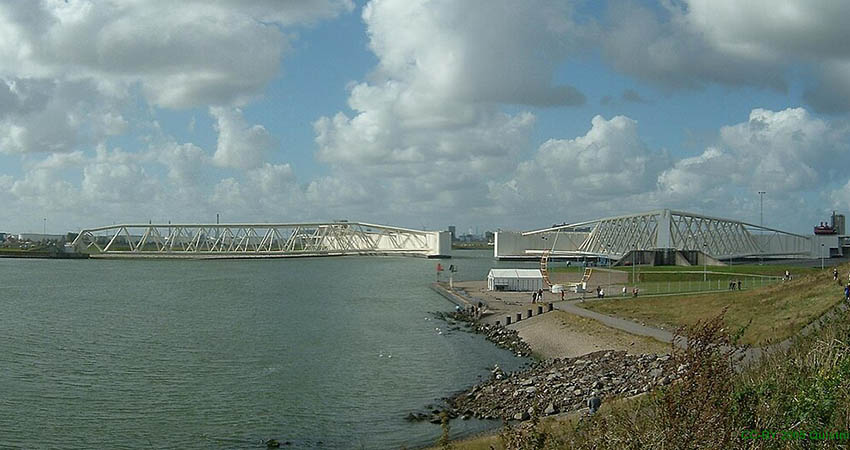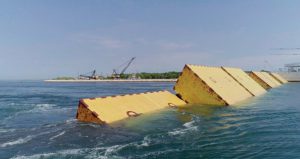World’s largest storm surge barrier closes for first time during storm

-
 Fergal MacErlean
Fergal MacErlean
Share article:
The world’s largest storm sturge barrier Maeslantkering in the Netherlands closed in December 2023 for the first time in 26 years during a storm. Storm Pia, which hit the Netherlands, Belgium, northern Germany, southern Scandinavia, and the UK, on 21-22 December created a storm surge that reached up to three metres above the normal high tide mark. This forced the closure of Rotterdam’s Maeslant storm surge barrier, the largest moveable object in the world.
It was the first time since its completion in 1997 that the Dutch storm surge barrier has closed during a storm. The fully-automated barrier protects the city and its port from floodings from the North Sea. The other five major storm surge barriers in the Netherlands also had to be closed due to Storm Pia. On the morning of 21 December the largest inflatable storm surge barrier in the world, the Ramspol, was closed. This was followed by the closure of the Hollandsche IJsselkering, the Haringvliet locks and the Eastern Scheldt Barrier. Just after 22.00, the Maeslantkering and Hartelkering were the last of the barriers to be closed. The closure of all six storm barriers was a unique event.
Delta Works
Approximately two thirds of the densely-populated, low-lying, county of Zuid-Holland is vulnerable to flooding. The storm surge barrier Maeslantkering, located near the Hook of Holland and the Port of Rotterdam, is a vital part of the country’s Delta Works and is designed to withstand a storm surge of five metres above the normal Amsterdam level (NAP), which is close to the average North Sea sea level. The forward flood surge barrier takes the full brunt of a tidal surge. Together with the Hartel Barrier and the extended Rozenburg Dyke, it forms the Europoort Barrier. The Maeslant Barrier is programmed to close automatically at a water level of three metres above NAP. Its two doors, each 210 metres wide and 22 metres high, fill with water when the barrier closes. They then sink to the sea bed in about two hours.
Storm with high impact
The deployment of flood barriers also took place in several other major European cities, with the Elbe and Danube rivers reaching relatively high water levels, though not causing significant damage. Germany bore the brunt of the impact, with substantial impacts in Denmark, France, and Austria. The storm claimed five lives – one each in Denmark, Austria, Belgium, the Netherlands, and the Czech republic – and left several others injured. It unleashed intense wind gusts exceeding 100 metres per second (360kph) across large portions of the continent; the Scottish mountain Cairn Gorm (1,245m), close to Ben Nevis, recorded a record-breaking wind gust of 185kph. Strong rainfall in combination with the storm lead to widespread flooding in parts of Germany, and caused major disruptions in holiday travel, with many cancelled ferries, trains and flights. Thousands of homes lost power due to downed power lines.
Water safety in the Netherlands
In the Netherlands, many water boards along the coast, including the IJsselmeer and the Wadden Sea had implemented dike monitoring due to the storm in combination with high water. This together with the closing of the surge barriers, nature-based solutions, and the renowned intricate system of dikes, drainage, and pumping stations, ensured the safety of Dutch citizens, the Netherlands Water Partnership (NWP) said. The NWP is a network of Dutch water organisations, which works worldwide on co-creating future-proof solutions on global water impact.
Living below sea-level
The Netherlands are located below sea-level. After the desastrous floods in 1953 the Delta Works were realised. The Delta Works were finalised in 1997 with the completion the world’s largest storm surge barrier Maeslantkering. Due to climate change and the expected rise of the sea-level extra flood protection will be needed in the future. Research in 2020 suggested that only dams of nearly 600 kilometres could protect northern Europe against a sea level rise of a minimum of two metres.











